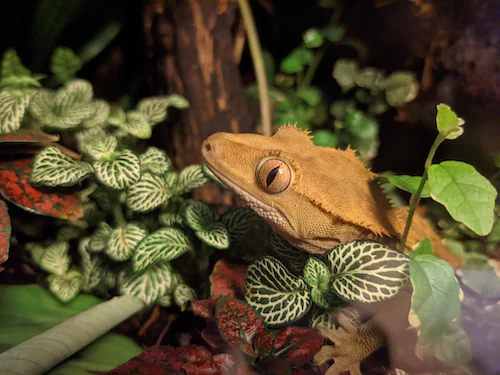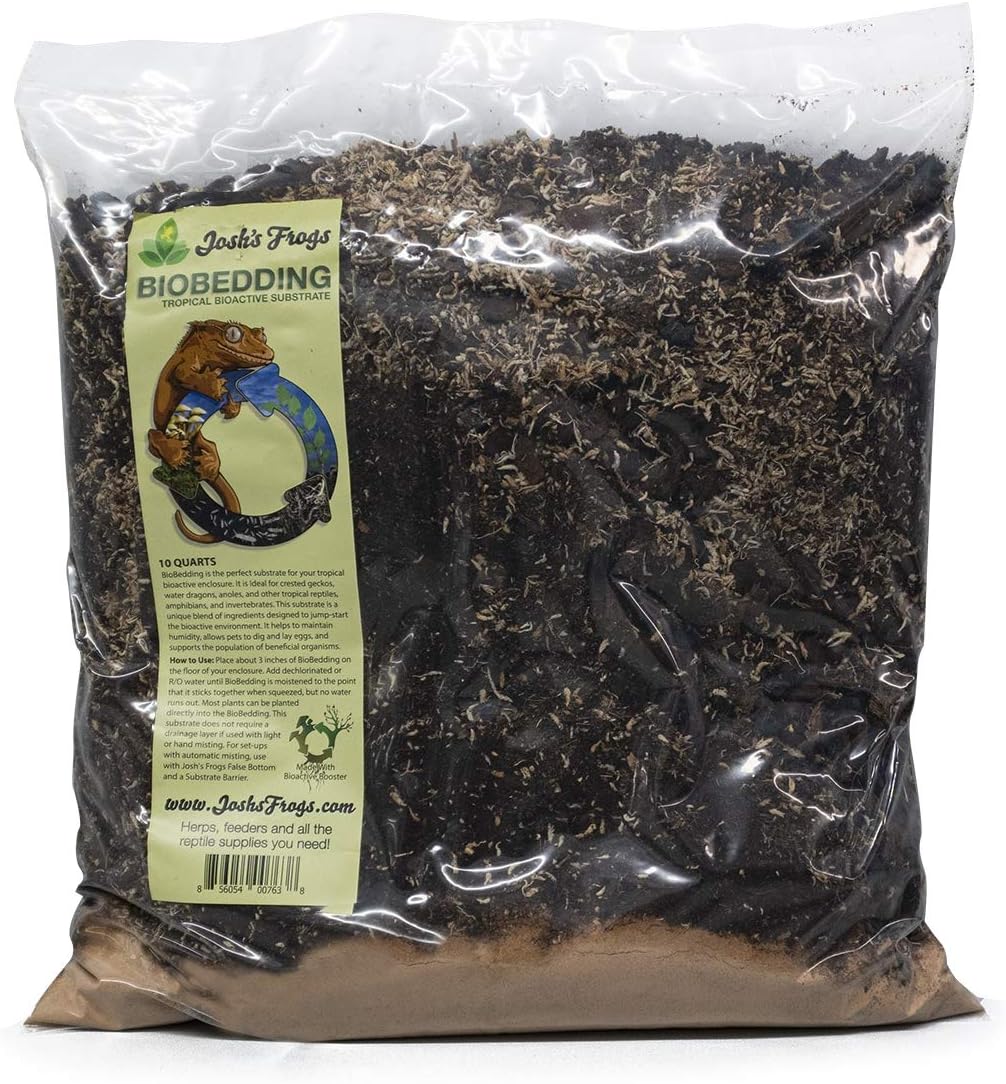
Crested Geckos are captivating pets, known for their unique appearance and engaging behaviors. As a Crested Gecko owner or enthusiast, providing the best care for these delicate creatures is paramount. A critical aspect of their care lies in choosing the right substrate for their enclosure. The right substrate not only impacts the health and comfort of your Crested Gecko but also plays a vital role in creating an environment that closely mimics their natural habitat. In this guide, we delve into the best substrates available in 2023, focusing on their features, benefits, and how to choose the perfect one for your scaly friend.
Why Substrate Matters for Crested Geckos:
Substrates serve multiple purposes in a Crested Gecko’s enclosure. Firstly, they help in maintaining the right humidity levels, which is crucial as these geckos thrive in moderately humid environments. Additionally, the right substrate can encourage natural behaviors like burrowing and climbing, contributing to the overall well-being of your gecko. However, not all substrates are created equal. Some can pose risks like impaction (if ingested), while others might not hold moisture effectively, leading to an unsuitable environment for your gecko. This makes the choice of substrate a significant decision for every Crested Gecko owner.

Table: Comparison of Top 5 Crested Gecko Substrates in 2023:
| Substrate | Moisture Retention | Safety | Price | Best For | Buy Now |
|---|---|---|---|---|---|
| Zoo Med Eco Earth | High | Very Safe | $31.00 | High Humidity Environments | Buy Now |
| Exo Terra Plantation Soil | High | Very Safe | $5.99 | Bioactive Terrariums | Buy Now |
| Josh’s Frogs BioBedding Tropical | Moderate | Safe | $31.99 | Odor Control | Buy Now |
| Zilla Jungle Mix | High | Very Safe | $12.98 | Naturalistic Setups | Buy Now |
| The Bio Dude Terra Fauna | High | Safe | $24.95 | Bioactive Enclosures | Buy Now |
Zoo Med Eco Earth Loose Coconut Fiber Substrate:
Zoo Med’s Eco Earth is a top choice for many Crested Gecko enthusiasts. Made from natural coconut fiber, it excels in retaining moisture, thereby maintaining the humidity that these geckos love. It’s not only effective but also eco-friendly, being completely biodegradable. While it’s safe if ingested in small amounts, it’s always wise to monitor your gecko’s behavior to prevent any potential issues.
Exo Terra Plantation Soil:
This substrate is a favorite for those setting up bioactive terrariums. Derived from compressed coconut husk, Exo Terra Plantation Soil is ideal for retaining moisture and supporting the growth of live plants. It’s also safe for your geckos and contributes to creating a dynamic and naturalistic environment in the enclosure.
Josh’s Frogs BioBedding Tropical Bioactive Substrate:
Perfect for those looking to create a self-sustaining ecosystem, Josh’s Frogs BioBedding is specifically designed for tropical environments. It’s excellent at maintaining humidity and controlling odor, making it a practical choice for busy gecko owners. Plus, it supports the growth of beneficial microfauna, adding to the bioactive experience.
Zilla Jungle Mix:
Combining sphagnum moss and fir shavings, Zilla Jungle Mix is ideal for retaining moisture and simulating a forest floor. This substrate is particularly good for geckos that enjoy a more humid environment and those who love to burrow. It’s also completely natural, adding an aesthetic appeal to the terrarium.
The Bio Dude Terra Fauna:
This substrate is a premium choice for Crested Gecko owners. Terra Fauna is specifically formulated for rainforest habitats, making it perfect for maintaining the right balance of humidity and fostering plant growth. It’s a bit on the pricier side but well worth it for its quality and effectiveness in creating a thriving bioactive environment.
User Tips for Crested Gecko Substrates
Ensuring the wellbeing of your Crested Gecko involves more than just selecting the right substrate. Proper usage and maintenance are key. Here are some valuable tips for Crested Gecko owners to get the most out of their chosen substrates:
1. Layering the Substrate:
- Depth Matters: Aim for a substrate depth of about 2-3 inches. This allows your gecko to burrow and helps in maintaining the necessary humidity levels.
- Even Spread: Ensure the substrate is evenly spread across the bottom of the enclosure to avoid uneven moisture distribution.
2. Maintaining Humidity:
- Regular Misting: Use a spray bottle to mist the enclosure. Different substrates require different misting frequencies, so adjust accordingly.
- Monitoring Tools: Invest in a reliable hygrometer to keep track of humidity levels, ensuring they stay within the ideal range for Crested Geckos (50-70%).
3. Cleaning and Replacement:
- Spot Cleaning: Regularly remove waste and uneaten food to prevent mold and bacterial growth.
- Full Replacement: Replace the entire substrate every 3-6 months, or more frequently if it becomes overly soiled or damp.
4. Preventing Ingestion:
- Feeding Dish: Use a shallow dish for feeding to minimize the chance of your gecko ingesting the substrate.
- Observation: Keep an eye on your gecko’s behavior. If they seem to be ingesting substrate regularly, consider switching to a different type or consult a vet.
5. Creating a Natural Environment:
- Mix and Match: Don’t be afraid to mix substrates to achieve the desired consistency and humidity level.
- Adding Elements: Incorporate elements like moss, bark, and leaves to create a more natural and enriching environment.
6. Handling Bioactive Substrates:
- Cultivating Microfauna: If using a bioactive substrate, introduce beneficial microorganisms like springtails and isopods to help break down waste.
- Plant Integration: For substrates supporting plant growth, choose plants that are safe and beneficial for Crested Geckos.
7. Substrate and Temperature:
- Avoid Overheating: Ensure heating elements are not in direct contact with the substrate to prevent drying out or overheating.
- Temperature Monitoring: Use a thermometer to monitor the temperature at the substrate level, ensuring it’s suitable for your gecko.
8. Customizing for Your Gecko:
- Consider Your Gecko’s Age: Younger geckos might prefer different substrates compared to adults, especially in terms of softness and ease of movement.
- Observe Preferences: Each gecko is unique. Observe your gecko’s interaction with the substrate and adjust based on their preferences and behaviors.
Incorporating these tips can significantly enhance the living conditions of your Crested Gecko, contributing to their health and happiness. Remember, the key to successful gecko care lies in observation and adaptation to their needs. By carefully selecting and maintaining your substrate, you provide a foundation for your gecko to thrive.
Frequently Asked Questions About Crested Gecko Substrates
Q1: Can Crested Geckos live on sand?
- A: It’s generally not recommended to use sand as a substrate for Crested Geckos. Sand can lead to impaction if ingested and doesn’t retain humidity well, which is crucial for these geckos. Instead, opt for substrates like coconut fiber or sphagnum moss that hold moisture and are safer if accidentally ingested.
Q2: How often should I change my Crested Gecko’s substrate?
- A: The substrate should be fully replaced every 3-6 months. However, you should also do regular spot cleaning to remove waste and food debris. If you notice any foul odor or excessive dampness, it might be time for an earlier change.
Q3: Is it safe to mix different substrates?
- A: Yes, mixing substrates can sometimes create an ideal environment. For example, mixing coconut fiber with sphagnum moss can help in achieving the desired humidity level. However, ensure that all mixed substrates are safe for Crested Geckos.
Q4: Can I use regular soil for my Crested Gecko?
- A: Regular garden soil is not recommended for Crested Geckos. It may contain fertilizers, pesticides, or other chemicals harmful to your pet. It’s best to use commercial substrates specifically designed for reptiles.
Q5: How does substrate impact the humidity in the enclosure?
- A: Substrates play a crucial role in maintaining humidity. Some, like coconut fiber and moss, retain moisture well and help keep the enclosure humid. Others may dry out quickly and are less ideal for maintaining the required humidity levels.
Q6: Do I need a different substrate for a bioactive enclosure?
- A: Bioactive substrates are specifically designed to support a micro-ecosystem, including live plants and microfauna. These substrates are usually a mix that supports plant growth and is conducive to the activities of beneficial cleaning insects.
Q7: Are there any substrates I should avoid for Crested Geckos?
- A: Avoid substrates like gravel, sand, or walnut shells, as they pose a risk of impaction and do not retain moisture well. Also, steer clear of cedar or pine shavings, as they can be toxic to reptiles.
Q8: How do I clean the substrate in my gecko’s enclosure?
- A: For cleaning, remove your gecko from the enclosure, and remove any waste, leftover food, or shed skin. For deep cleaning, when you replace the substrate entirely, clean the enclosure with a reptile-safe disinfectant and rinse thoroughly before adding new substrate.
Q9: Can I use a heating pad under the substrate?
- A: Yes, but with caution. Ensure that the heating pad is regulated with a thermostat to prevent overheating and monitor the substrate temperature to ensure it’s safe for your gecko.
Q10: How do I prevent mold growth in the substrate?
- A: To prevent mold, avoid over-wetting the substrate and ensure good ventilation in the enclosure. Regular spot cleaning and full substrate changes also help in preventing mold growth.
Setting the Foundation for a Happy, Healthy Crested Gecko
As we’ve explored in this comprehensive guide, choosing the right substrate for your Crested Gecko is not just a matter of aesthetics; it’s a crucial step in ensuring the health and well-being of your beloved pet. The substrates we’ve discussed – from the moisture-rich Zoo Med Eco Earth to the versatile Bio Dude Terra Fauna – have been carefully selected to meet the unique needs of Crested Geckos. They offer more than just a ground cover; they create a micro-habitat that supports the natural behaviors, health, and happiness of your gecko.
By considering one of these top substrates for 2023, you’re not just buying a product; you’re investing in an environment that mimics the natural world from which these fascinating creatures originate. Whether it’s maintaining optimal humidity levels with Exo Terra Plantation Soil or fostering a bioactive ecosystem with Josh’s Frogs BioBedding, each substrate brings its unique benefits to your terrarium.
Remember, the substrate you choose can significantly impact the overall quality of life for your Crested Gecko. A well-chosen substrate contributes to proper humidity regulation, offers a comfortable and naturalistic ground for exploration and burrowing, and can even aid in the health and hygiene of your pet’s environment.
So, as you consider the best care for your Crested Gecko, I encourage you to explore these top substrate options. Each product link in this article is your gateway to creating the ideal habitat for your gecko. These aren’t just purchases; they are steps towards enriching the life of your pet. By selecting the right substrate, you lay the groundwork for a thriving, vibrant ecosystem where your Crested Gecko can flourish.
In the end, the joy and well-being of our scaly friends are what truly matter. Let’s give them the best of what we can offer – starting from the ground up.





